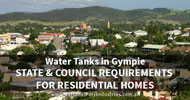
The Gympie region is found in South East Queensland approximately 2 hours north of Brisbane. With an area of 6,898 square kilometres, it offers picturesque experiences from the rolling hills and market villages of the Mary Valley, to quaint country towns of Kilkivan and Goomeri and pristine coastal areas of Rainbow Beach. Today it has a residential population of around 50,000 people.
If your home is in the Gympie area, and you are preparing to install a water tank, have in mind that there are both Queensland state and local council requirements that you must comply with. This article aims to provide you with a summary of these requirements, however prior to beginning work please contact
Gympie Regional Council to ensure compete accuracy and currency of information presented below.
State Level Rainwater Water Tank Requirements (Queensland)
Unless your local Council stipulates otherwise, rainwater tank installation is a voluntarily affair if you reside in Queensland. Unlike other states, there are generally no requirements that define:
- a minimum tank size
- a minimum roof catchment area
- internal plumbing connections to supply fixtures, such as toilets and a washing machine
- a continuous supply of water.
In the past, new houses, commercial and industrial buildings have been required to meet water saving targets through rainwater tanks or grey water treatment plants. The Queensland state government has in recent years
updated these requirements such that if opting for a rainwater tank with a Class 1 building,
- a minimum roof catchment area of half the total roof area or 100m2 (whichever is less); and
- a minimum capacity of 5,000 litres for detached buildings, or a minimum capacity of 3,000 litres for all other dwellings.
Class 1 buildings are defined as any single dwelling (a detached house) or one or more attached dwellings separated with a fire-resisting wall, and boarding or guest house, hostel or similar with a total floor area not exceeding 300m
2 and where a maximum of 12 people reside.
General Rainwater Tank Install Requirements
In Queensland, where a rainwater tank is connected for indoor use to an existing house or building, your licensed plumber needs to lodge a form notifying of the plumbing work where internal fixtures are connected to the reticulated town water supply.
In addition, all rainwater tank installations must:
- have suitable protection against insects, mosquitoes and vermin, for example through metal screen meshing applied to all openings with an aperture of no greater than 1mm.
- take suitable measures that prevent contaminants from entering the tank, for example installing a water diverter that captures a minimum of 20 litres of the first flush of rainwater from the roof.
- provide protection against backflow contamination of a reticulated town water supply system (if an rainwater to mains water switched device is installed). A backflow prevention device that complies with AS/NZS 3500:2004 is an adequate solution.
- have appropriate warning signs on a tank identifying it as rainwater, or if recycled water, warning signs of recycled water not for drinking on the tank as well as all outlets.
- not allow surface stormwater and groundwater to seep in when installed underground, for example, all opened need to be appropriately sealed.
Gympie Regional Council Water Tank Requirements
Falling into line with Queensland requirement, the Gympie Regional Council requires a licensed plumber to install your rainwater tank if it is plumbing to into your home or interconnected to your mains water supply. The same approval process if connected to a reticulated water supply is required.
For tanks storing water that is used solely for irrigation purposes, such as watering gardens, lawns and the like, a licensed plumber isn’t necessary nor is any approval.
Visual Considerations
The Council also generally requires you to consider water tank installation factors such as:
- maximisation of the rainwater roof catchment area
- minimisation of the visual impact of the tank on the neighbourhood
- avoid detraction from the surrounding outdoor space
- use of finish and colour that complement the existing buildings
Mains Water to Rainwater Switch
If your tank has a rainwater to mains water switching device, then you will need to install a backflow prevention device, have it inspected annually and properly maintain it according to the
Plumbing and Drainage Act 2002.
The Council maintains a program for the registering, maintenance and testing of backflow prevention devices as per Section 38 – Testable backflow prevention devices found in the
Standard Plumbing and Drainage Regulation 2003.
More information on
Gympie’s backflow prevention requirements can be found on the Gympie Regional Council website.
 The Gympie region is found in South East Queensland approximately 2 hours north of Brisbane. With an area of 6,898 square kilometres, it offers picturesque experiences from the rolling hills and market villages of the Mary Valley, to quaint country towns of Kilkivan and Goomeri and pristine coastal areas of Rainbow Beach. Today it has a residential population of around 50,000 people.
If your home is in the Gympie area, and you are preparing to install a water tank, have in mind that there are both Queensland state and local council requirements that you must comply with. This article aims to provide you with a summary of these requirements, however prior to beginning work please contact Gympie Regional Council to ensure compete accuracy and currency of information presented below.
The Gympie region is found in South East Queensland approximately 2 hours north of Brisbane. With an area of 6,898 square kilometres, it offers picturesque experiences from the rolling hills and market villages of the Mary Valley, to quaint country towns of Kilkivan and Goomeri and pristine coastal areas of Rainbow Beach. Today it has a residential population of around 50,000 people.
If your home is in the Gympie area, and you are preparing to install a water tank, have in mind that there are both Queensland state and local council requirements that you must comply with. This article aims to provide you with a summary of these requirements, however prior to beginning work please contact Gympie Regional Council to ensure compete accuracy and currency of information presented below.

